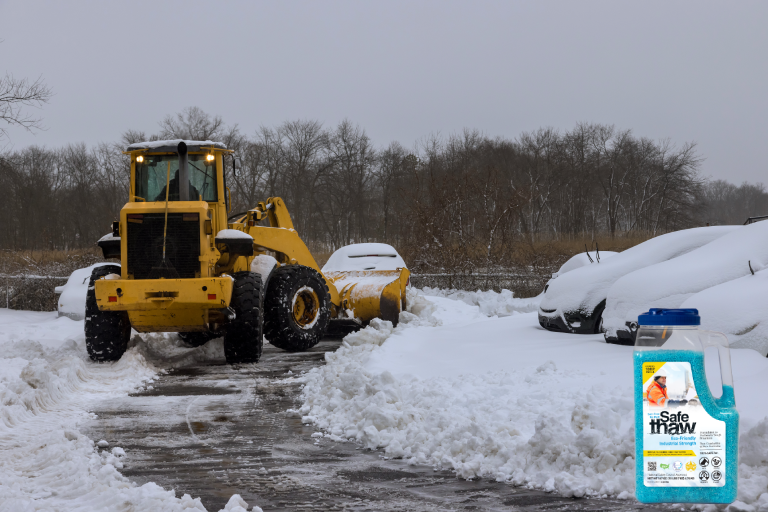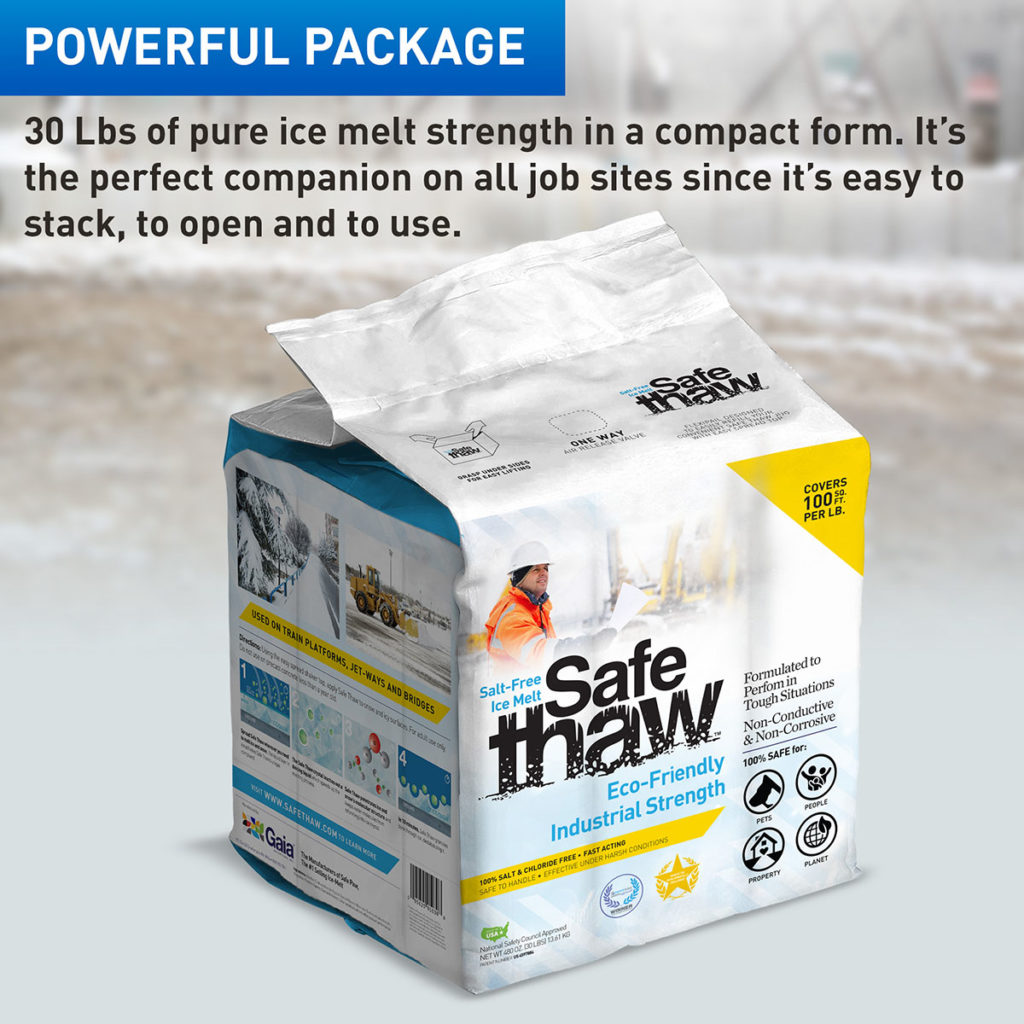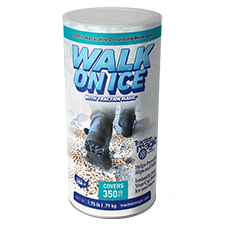Stamped Concrete Prone To Damages – Choose Your Ice Melt Wisely

Using stamped concrete is another way to construct an aesthetic-looking driveway to add curb appeal. What ice melt is safe for stamped concrete is one of the pressing questions we face every winter. Several products in the market guarantee safety for concrete surfaces, asphalt, and other decking materials. They also claim to be safe for your pets and kids, but not everything you read is true.
Stamped Concrete Prone to Damages? Choose Your Ice Melt Wisely
Stamped concrete is an attractive and durable choice for driveways, walkways, and patios. However, its textured surface and sealed finish make it more vulnerable to damage from harsh deicing agents, especially during freeze-thaw cycles. Choosing the right ice melt is crucial to maintaining its beauty and structural integrity.
In this guide, we’ll explore eco-friendly alternatives, proper application techniques, and maintenance tips to protect your stamped concrete while ensuring safe and effective ice removal. We’ll also discuss how to remove ice from driveway without salt and compare the advantages of concrete vs asphalt driveway to help you make informed decisions.

Safe Thaw
Safe Thaw was created as the ice management solution for tough winter environments. Ideal in commercial and industrial properties, shops, government agencies, bridges, and construction.
Stamped concrete can look like any iconic shape and texture, such as slate, brick, tile, or natural stone. It adds a gorgeous look to your driveway and exudes elegance. So, to answer your question about what is best ice melt for concrete, we present a 100% safe product- Safe Thaw. Comprising ice-melting boosters, special surfactants, and unique glycols, this urea-modified product is dual-patented and does not harm the environment.
But stamped concrete is prone to damage because it is laid differently and customized according to the homeowners’ needs. Choose your ice melt wisely to ensure you do not face any backlash during winter.
Composition
Since stamped concrete has an aesthetic appeal, you wouldn’t want to ruin the surface by seeing heavy salt residue or staining. Check the composition of the ice melt before purchasing one. If it has a high sodium chloride or rock salt concentration, you may have some problems with staining once it dries. This will spoil the stamped concrete and make you wonder what ice melt is safe for stamped concrete!
Application
You have spent thousands of dollars customizing a driveway or pathway of your choice. You have given it a look; you want to match the house’s exteriors and interiors. But wait! You end up overusing ice melt products only to realize you never checked the quantity to be applied. Check the instruction on the back of the pack before spreading the mixture. With Safe Thaw, you have the instruction right on top where you use only ½ cup per 100 sq. ft., making it easy to apply.
Usage
There is a way to maintain stamped concrete while using any ice melt product. Spread it evenly before the snowfall, and if it is slightly cracked, it will be best to use a sealant on the crack before applying the ice melt. Once you clear the excessive snow, you can easily spread the next round of ice melt, such as Safe Thaw, on the icy layer and see it work its magic.
Environmental Impact of Deicing Agents on Stamped Concrete
Deicing agents, while effective at melting ice, can have long-term environmental and structural impacts.
Soil and Water Contamination
Many traditional deicers, such as sodium chloride and calcium chloride, leach into the ground, increasing soil salinity and harming nearby vegetation. Runoff from deicers also contaminates local water sources, posing a threat to aquatic ecosystems.
Impact on Concrete Surfaces
Stamped concrete is particularly vulnerable to scaling and spalling caused by chloride-based deicers. These chemicals penetrate the surface, exacerbating freeze-thaw damage and compromising the protective sealant.
Eco-Friendly Alternatives
Switching to environmentally friendly deicing products like concrete safe ice melter solutions, such as Safe Thaw, can minimize environmental harm while preserving your stamped concrete.
Comparative Analysis of Deicing Products for Stamped Concrete
Choosing the right deicing product can be overwhelming. Here’s a breakdown of popular options:
Traditional Deicers
- Sodium Chloride (Rock Salt): Inexpensive but highly damaging to stamped concrete and vegetation.
- Calcium Chloride: Effective in low temperatures but accelerates scaling and spalling on decorative concrete.
Eco-Friendly Deicers
- Safe Thaw: A chloride-free, non-toxic ice melt specifically designed for concrete surfaces. It offers effective deicing without compromising stamped concrete durability.
Non-Chemical Options
- Sand or Gravel: Provides traction but does not melt ice. Useful as a supplement to eco-friendly deicers.
- Heated Mats: An upfront investment but eliminates the need for deicing chemicals altogether.
Best Practices for Applying Deicers on Stamped Concrete
Even the best deicers can cause damage if not used correctly. Follow these tips to ensure safe and effective application:
Apply Sparingly
Avoid over-application of deicers. Excess product increases the risk of surface damage and environmental harm.
Clear Snow Promptly
Shovel or sweep snow immediately after a snowfall to reduce the amount of ice that forms, minimizing the need for deicers.
Use Protective Mats
Place mats on high-traffic areas of stamped concrete to shield the surface from direct contact with deicers.
Test Before Use
Perform a small patch test with any deicer to ensure it doesn’t compromise the finish or color of your stamped concrete.
Long-Term Maintenance Strategies for Stamped Concrete Durability
Proper maintenance ensures your stamped concrete remains both functional and visually appealing for years.
Regular Cleaning
Clean your stamped concrete regularly to remove dirt, debris, and any residual deicing chemicals. Use a mild detergent and a soft-bristle brush to avoid scratching the surface.
Seal the Surface
Reapply a high-quality concrete sealant every 2–3 years to protect against moisture penetration and freeze-thaw damage. A good sealant also enhances the color and texture of stamped concrete.
Repair Minor Damage Promptly
Address cracks, chips, or surface wear immediately to prevent further damage. Small issues can quickly escalate if left untreated.
Winter Preparations
Before winter begins, ensure your stamped concrete is well-sealed and free of existing damage. Use eco-friendly deicers and consider using mats or sand for additional protection.
Concrete vs Asphalt Driveway: Which Is Better?
Both concrete and asphalt have unique advantages, but understanding their performance during winter can help you choose the best option for your needs.
Durability
- Concrete: Stamped concrete is long-lasting and can withstand heavy loads, but it’s more susceptible to scaling if exposed to deicers.
- Asphalt: Less expensive upfront but requires frequent maintenance and resealing.
Winter Performance
- Concrete: Needs eco-friendly deicers to prevent damage.
- Asphalt: Handles deicers better but can soften in extreme heat.
Cost Comparison
- Concrete Driveway Cost: Higher initial cost ($6–$15 per square foot) but lower maintenance expenses.
- Asphalt Driveway Cost: Lower upfront cost ($3–$7 per square foot) but higher long-term maintenance.
Stamped concrete offers better aesthetics and longevity, making it a worthwhile investment with proper care.
100% salt & chloride-free, fast acting Ice Management Solution
Conclusion
Choosing the right deicer is critical to maintaining the durability and beauty of your stamped concrete. By understanding how to remove ice from driveway without salt and selecting eco-friendly options like Safe Thaw, you can protect your driveway while minimizing environmental harm.
Pair these deicing practices with regular cleaning, sealing, and prompt repairs to ensure your stamped concrete stays in top condition. Whether you’re comparing concrete vs asphalt driveway or exploring the best concrete safe ice melter, informed choices will help you achieve a long-lasting, eco-friendly solution for winter driveway maintenance.
Start making smarter choices today to keep your stamped concrete safe and stunning!
Try Also Our Other Winter Safety Products:
Safe Paw
The Original and #1 Selling Pet and Child Safe Ice Melt for over 20 years. Guaranteed environmentally safe –It won’t harm animals or children, and it won’t damage your property. That’s Safe Paw. Safe Paw can change how winter affects our planet.

Walk On Ice
The handy disposable canister can be taken everywhere, with the same 100% naturally occurring minerals that provide instant traction on ice or snow. Use it on sidewalks, steps, or as an instant traction agent for your car.



